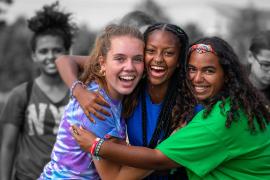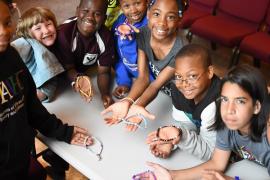You expect your staff to think on their feet — so why not train them on their feet?
For more than three decades, I've been assisting camps, outdoor education centers, youth development agencies, and park and recreation organizations with their summer camp staff trainings. Over the years, I've created, collected, and shared hundreds of activities that I think make a significant difference in the unity, community, connection, and culture of a camp.
This year, I decided to compile a list of my favorite summer camp staff training activities. In addition to my own ideas, I've been lucky enough to persuade David Knobbe and Clare Marie Hannon of the C5 Youth Foundation (formerly known as Camp Coca Cola) to join this project. Collectively, we have nearly a hundred combined years of camp experience and more than a few good ideas for which activities really bring out the best in a summer camp staff and that explore valuable staff training and development topics. (Essential Staff Training Activities, available from the ACA Bookstore, contains fifty of the best staff training activities we know, in addition to dozens of tips, ideas, and suggestions for making staff training sessions active, engaging, memorable, effective, and fun!)
The following four activities are not only some of my personal favorites, but they cover a wide range of helpful staff training topics, from icebreakers, getting-to-knowyou activities, energizers and games just for fun to a very unique closing activity that is sure to "connect" your staff together. These are not only team-building activities, but team bonding, too — both of which are important for uniting your staff this summer. Best of all, once you have acquainted your staff with these activities, they can in turn use them with campers to continue the process of building a truly connected camp.
The Story of Your Name
Everyone has a story related to his or her name. Some of us are named after another member of our family, or perhaps even someone famous. Many of us know what our names would have been, had we been born the opposite gender. Our middle names are significant, too. For this activity, invite everyone to share the story of their name: how they came to have it; if they like it or not; any nicknames they might have; who else has their name. And, encourage them to end with the phrase "please call me . . . their name of choice here." In this way, everyone has the opportunity to say how they like to be addressed and what is positive about his or her name. This is a great way to build respect and is a very powerful activity indeed, especially if you happen to have a culturally diverse staff.
If time permits, perform this activity with your entire staff together in the same place. Then every member of your staff will hear and learn how everyone else would like to be addressed. You'll need sixty to ninety seconds per person, so plan accordingly.
At many camps, counselors and staff use nicknames rather than their own names. At one camp, I heard a camp nickname that surprised me. And when I saw the person they were calling, I could tell that this particular nickname diminished this person. After leading The Story of Your Name with this summer camp staff, several members of the group were able to "re-create" themselves in a more positive light with their choice of staff names. Changing the culture of a camp starts in small steps. Building respect by using names that staff members find appropriate and positive is a good start. And this not only works with your camp staff but with campers as well.
Wrapped Around My Finger
The title for this get-acquainted activity, Wrapped Around My Finger, pretty much explains this entire activity. Begin with an unknotted length (fifteen feet) of tubular webbing (known as a Raccoon Circle*). One person in the group begins wrapping the webbing around their index finger, and while doing so, provides the group with some information about themselves (where they were born, family members, school experiences, childhood pets, dreams, goals, favorite foods, etc.) The goal is for this person to continue talking until the webbing is completely wrapped around their finger. When they reach the end, they unwind the webbing and pass it along to the next person in the group.
This particular technique allows a bit more time for folks to talk about themselves, and also provides a kinesthetic activity coupled with a verbal activity for exploring some multiple intelligence opportunities and whole brain learning possibilities. There is also an educational theory that for folks who may be a bit shy about speaking to even a small group in public, the act of wrapping the webbing around their finger occupies that portion of the brain that controls nervousness. By wrapping and "rapping" at the same time, the speech center becomes less inhibited, and more information is typically shared. And the more information shared, the greater the opportunities for making connections with other staff members.
Nose Jousting
This is absolutely one of my favorite camp challenges and energizers. Begin by providing all participants with a piece of masking tape. Instruct them to fold this tape into a circle, sticky-side out, and place it on their nose. The challenge begins with two opponents facing each other. They make contact with the tape on their noses, and as they pull away, one person will ‘win' the round by capturing both pieces of masking tape. The winner is allowed to re-affix the tape to his or her nose between rounds. The losing opponent then becomes the cheering section for the champion, standing behind the winner with his or her hands on the winner's shoulders — chanting the winner's name as he or she takes on other opponents. When a challenger beats a player with many members of their cheering section attached, they ALL become the cheering section for the new champion. The competition continues until a final champion wins (complete with a large glob of masking tape on his or her nose!).
I've heard for years that sports builds character. After using this activity, I believe it. Everyone that challenges and loses in this activity quickly becomes part of the cheering section for the opponent that bested them. And that is great sportsmanship! Best of all, anyone can win. It feels pretty good when dozens of people are chanting your name! And even losing challengers quickly become part of winning teams. In the end, especially with large groups, you'll have dozens of people chanting the names of their champions, creating great energy and enthusiasm.
The Big Brothers/Big Sisters organization of Rochester, New York, uses Masking Tape Jousting as a way to discuss comfort zones between bigs and littles in their programs. They first begin this activity by placing the masking tape on the knuckles of one fist, and allowing everyone to compete in this manner. Then they move onto the "nose" version, which requires players to share their personal space. A suitable discussion then occurs reminding bigs that they cannot force or speed through the trust-building stage with littles. Comfort zones and personal space must both be respected for a successful big/little relationship.
A Circle of Connection
The goal of this closing activity is to create a linked chain of staff members, connected together by those parts of camp that they love the most.
A leader begins by introducing herself, placing her hands on her hips (to create the first link of chain) and sharing what she enjoys most about camp, such as, "I like the morning polar bear swims, pizza for lunch in the dining hall, and the sounds of singing coming from the campfire circle." The very first person who also enjoys one of these camp-related activities, links arms with the leader (and becomes the second link of chain). He introduces himself and begins talking about the elements of camp that he enjoys, until the third person links to them.
This process continues until everyone in the group is connected together. The final person continues to chat until the first person can link to her. At this point, there is an opportunity to say, ". . . and by the way. Those things that link us together, bring us a bit closer together as well!"
Jim Cain, Ph.D., is the author of five teambuilding texts including Teamwork & Teamplay and A Teachable Moment, and is a presenter at many of the ACA regional and national conferences this year. You can find even more information for creating unity, community, connection, and teamwork at your camp, by visiting: www.teamworkandteamplay.com or by calling the author at 585-637-0328. Essential Staff Training Activities by Jim Cain, Clare Marie Hannon and Dave Knobbe, can be ordered from the ACA Bookstore (www.ACAbookstore.org) and Kendall/Hunt Publishers.
* Raccoon Circles are fifteen foot (4.6 meters) long segments of tubular climbing webbing with which you can facilitate group activities. See the ACA Bookstore publication The Revised and Expanded Book of Raccoon Circles, by Jim Cain and Tom Smith for over two hundred activities that you can facilitate with groups, or download the free document on using Raccoon Circles with groups at www.teamworkandteamplay.com (click on the "downloads" button of the navigation bar).
Originally published in the 2009 March/April issue of Camping Magazine.



